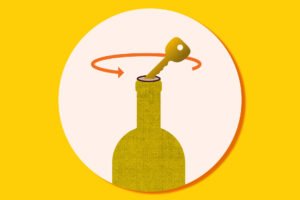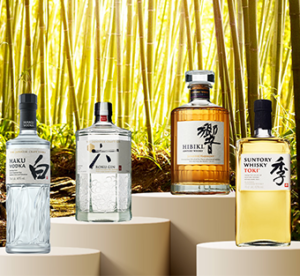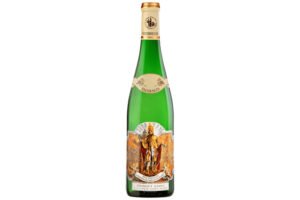Shining a Light on South African Wine

[ad_1]
South Africa bridges the Old and New Worlds of wine, but it also has some unqiue challenges.

© Stellenbosch Wine Routes
| The rolling hills of Stellenbosch have been growing grapes for more than 300 years.
South Africa is one of those wine-producing countries that happily straddles the line between Old World and New.
With a wine-producing history going back 363 years, it can hardly be considered new, but its course over those years has been hindered and hampered by various political instabilities, inequalities and infighting.
The past 20 years, however, have finally given South African wine a chance to explore its identity as a bright industry with Old World experience and New World edge. Driven by a small but passionate group of people, South African wines have found their wings and, as our search data shows, are taking off.
There were 18,000 searches for South African wine in the UK, which made up 1.9 percent of all wine searched for in April 2018. Fast-forward to April 2022 and there were 26,000 searches for South African wine in the UK making up 2.1 percent of all wines searched for.
On a global scale, it’s even more impressive; back in April 2018, South Africa accounted for 0.9 percent of all worldwide searches – roughly 118,000. Since then, it has climbed to 182,000 searches and now makes up 1.1 percent of all wine searches worldwide.
In a chat with Maryna Calow, communications manager for Wines of South Africa (WOSA), she outlined the industry’s fierce fight for the recognition they believe their wines deserve.
Who are Wines of South Africa?
We are the export marketing council for the South African wine industry. So we basically represent all wine producers who export, which is pretty much all of them, to varying degrees – we are the international mouthpiece of our industry. Trying to make things as fair and even for all of our producers to participate in and get some kind of international footing.
We are industry funded – we’re not government funded – but we are government recognized and they collect statutory levies on the exports that come towards our funding. So for every litre of wine that gets exported, whether in bulk or package format, there’s a few cents that gets collected and shared with us to basically do marketing efforts around the world. Saying that we only work in key focus markets simply because the funding is very, very limited.
Our government funding is very limited. So everything we need to do has to be very focused, very strategic. Our producers have to pay for everything, it’s a very short shoestring.
It does present a challenge, but what it also does is it makes you think a little bit more creatively. Try and compete with our international counterparts – who do have massive budgets that they can play with – on the same playing field.
Where are your key markets and how do they operate?
We only operate in key focus markets, which are Canada, the USA, Germany, Netherlands, Sweden, the UK – which is our biggest export market. Asia, as a market, is really mainland China, Hong Kong and Japan. Then Africa as a continent, we only focus on key countries within the African continent.
We export about 50 percent of all our wine. In total, Europe – including the UK – takes about 50 percent of all our exports – it is a very big and very important market for us. We’re still very small players in the USA.

© WOSA
| Merlot and the other Bordeaux varieties are important grapes for the South African industry.
Africa is a really exciting market for us, we are fellow Africans and we do see a lot of support there. It’s not a traditional wine drinking market – it has never been – although wine has been present in key markets for quite some time having had links to France and Portugal.
East Africa – Kenya, Tanzania – they’ve been great. Mozambique – just across the border – has always been a nice market for us, we see a lot of excitement around wine in the ZimZam border where the Victoria Falls are, there’s a lot of tourism in that area and South African wine does well.
Ghana, Uganda and Nigeria – starting to move over to West Africa – are also very, very strong markets for us, as well as Angola. Closer to our borders, Namibia and Botswana – they’ve all been very good supporters of South African wine.
I think one thing to remember is a lot of those countries are Muslim, so it’s not a big thing. Even Kenya and Tanzania, they’ve got massive Muslim populations – so that’s not going to open itself up to wine quite so naturally.
In South Africa, if you look at our consumption stats, it’s only 8 percent of South Africans drink wine. We’re traditionally a beer and spirits drinking nation, about 80 percent of our consumption is beer.
What are South Africa’s flagship wines?
I personally think our Shirazes are sublime, that’s – for me – the most exciting of the reds from a quality perspective in terms of competing internationally. Quality-wise our Shiraz are stonkers and there’s some beautiful iterations.
We do some stellar blends, whether it is Bordeaux-style, Rhône-style, and – of course – the Cape Blend which has Pinotage in it.
People are starting to learn who is Durbanville, who is Elgin, Klein Karoo, Robertson – all of these regions are starting to make a bit of a name for themselves and to position themselves. What we’ve also recommended they do is hang their hook on something, whether it be a varietal, or a style but own it.
What we’ve done, from a greater industry perspective, is hang our hook on Chenin Blanc and Pinotage.
How important is Pinotage to the South African wine industry?
So Pinotage – very much one of the grapes we hang our hook on – is the truly proudly South African red variety that has come a long way.
It has been negatively seen in the past and engaged with negatively but that has very much changed over the last 10-20 years. What’s interesting about Pinotage is we’re seeing vineyards being planted in Australia and in America – Oregon and California – even in France. So it’s nice to see this variety being embraced.
Pinotage, there was a time when [it] had a bad rap, a lot of winemakers struggled to know what to do with it, but if you think of the parentage – which is Cinsault and Pinot Noir – should be treated with so much love and kitten gloves and respect, because it’s a lot more volatile and gentle.
We’re seeing some stunning Pinotages coming out now – much lighter in style, not that punchy, high alcohol [style]; we’re looking at 13 percent alcohols with elegance and refinement. Red berries, very lively, nice level of acidity, not too tannic. Not over extracted, not too heavily wooded, and that’s the style we’re starting to see. You can comfortably look at what you’d expect from a good Pinot Noir or a good Cinsault.
There will always still be those the old-school guys who are positioning themselves with the big blockbusters – they’ll always be there – but the ones that are doing well in international competitions are the more elegant and refined ones that are treated with the love and respect that they deserve.
And Chenin Blanc?
I think we’ve got over 17,000 hectares of Chenin Blanc planted here, after that, it’s about 9500 in the Loire. So it’s a significant amount of Chenin Blanc.
Traditionally, Chenin Blanc grapes were used for making distillation wine, brandy, and it’s only been in the last few years that producers have recognized “Listen, this is a fantastic grape, we can do amazing stuff. It’s incredibly versatile. You can make everything.” It’s stunning, it can be very fresh and fruity, or it can be wooded and heavier – they make Cap Classique from it, they make sweet wine from it.
For me, it bridges the gap between Sauvignon Blanc and Chardonnay because you get those fresh, fruity, crisp, acidic Savvies and the heavy Chardonnays and someone that goes, “oh no, I can’t do Chardonnay”, or “I can’t do Sauvignon Blanc”, this bridges the gap beautifully, it can be somewhere on the spectrum in between.
And finally, Cap Classique?
Cap Classique as a category, it’s one of our strongest growers at the moment, we’re seeing a lot of growth in Cap Classique exports. It’s a very high-quality product and it competes comfortably with Champagne from a quality perspective, but it is slightly cheaper so it falls in the segment just below, but it’s more expensive than the current flavour du jour which is Prosecco.
It’s also a lot more serious than Prosecco, and has a lot more depth. It’s the same process that they use for Champagne production, so it’s a nice go-to for someone who doesn’t want to pay for Champagne.
The American market is really taken to Cap Classique nicely, and, interestingly enough, China as well, which is traditionally a red wine drinking market – we’re seeing some nice growth there. The other market where we seeing nice growth is the Netherlands, the Netherlands are going through a sparkling wine renaissance.

© Aline Balayer
| Wine lovers are learning more about producers like Stellenbosch’s Neethlinghof.
What have been the biggest industry challenges?
Shipping – I know is a global issue – but ours was particularly exacerbated by the fact that we’ve had major issues at our main Cape Town port terminal – which is the main exporting terminal for the wine industry – because there haven’t been enough containers available.
A lot of the big freight companies have been bypassing the ports of Cape Town because of structural issues, equipment that’s out of date, that’s broken, creates a delay. Ships having to sit in the bay waiting for a berth for up to two weeks at a time. This is also big fruit farming area, the fresh fruit gets preference on these liners for obvious reasons, but that has caused a major issue for us.
We had massive floods in KwaZulu-Natal area as well – you see all these containers that are just lying toppled over in the mud. Of course, the whole shipping situation and container situation has been exacerbated by the war in the Ukraine.
We also have a glass shortage in our country that is directly related to the [Covid-related] alcohol bans. So that’s a real challenge that we’ve got.
Are rising costs a challenge?
So rising costs is a huge thing – ties into the port situation – we have to import barrels, we have to import corks, we have to import machinery, all of that in Euro currency, as well, which is a challenge.
We’ve seen the rising cost of fuel, which has a direct knock-on effect on everything else. So the challenges are real, certainly for the next five years. It’s about resilience for our industry, to be able to continue doing what we’re doing without losing traction.
We’ve shrunk quite significantly over the past 12-15 years, we had about 3500 primary producers, we’re down to about 2600 primary producers – it’s a big shift.
Many of those were lost planted alternative products – citrus, berries, nuts – but others have been lost due to consolidation, and that’s mainly due to the viability and financial sustainability of the industry, which has been very much under pressure.
Our plantings have gone from about 105,000 hectares to roughly 92,000. So the uprooting is a reality but what’s also been good is that the volume has stayed roughly the same which means that where vineyards have been replanted or uprooted and replanted – there are more viable varieties being planted, that are more drought resistant, that are yielding higher tonnage.
Women seem to play a strong role in the South African wine industry?
Well, there’s Women in Wine Exchange group [on Facebook], and that’s a very active little group. Our industry is still beyond a shadow of a doubt male-dominated, however, we about a quarter of our winemakers are women – and I say that with a fair amount of confidence – and they are celebrated very much in industry.
I think for some [female winemakers] – especially the older ones – it was definitely an uphill struggle, you listen to some of the stories that are told, a lot of comments that they had to endure.
There’s some awesome female winemakers who’ve done so well, both locally and internationally in terms of really making a name for themselves and winning awards, and being brand ambassadors, it’s exciting.
How does the future look?
I think the future is overall positive – still many challenges that we face – some still Covid related.
The positives are definitely there, our quality has improved significantly over the past 20 or so years. We’re certainly getting a lot of recognition internationally, whether it be through critics, the media, international competitions. I think it helps that the quality of our wine is as good as it is, and the value is as good as it is, but we can’t rely on cheap South African wine because that’s not where the answer is – we need to premiumize.
There have been some silver linings – the trade spat between Australia and China where the conditions have played in our favor. A lot of the existing brands that were traditionally Australian brands are now being bottled in South Africa under the same label to the same branding, but it is Wine of origin, South Africa.
In April last year, we saw a massive frost in Europe which – very sadly for our European counterparts – we’ve seen again in the last couple of weeks, similar story at budding phase. Frost, which we saw last year, played very favorably into our hands when there was a shortage of Sauvignon Blanc and Chardonnay. We even exported a fair chunk of Sauvignon Blanc to New Zealand, which is a surprise for us.
There is a yin and yang of life – as much as we don’t wish ill upon our fellow producers, we also have to harness any opportunity that comes.
Our wine tourism offering – from my perspective, having experienced a few other wine-producing regions – is second to none. We have a very strong offering in terms of hospitality, food – the scenery is absolutely spectacular. It’s a cheap destination to come to once you’ve once you’ve paid for your flights, which is normally the most expensive part.
Once you’re here, you’re in for a real treat.
To join the conversation, comment on our social media channels.
[ad_2]




